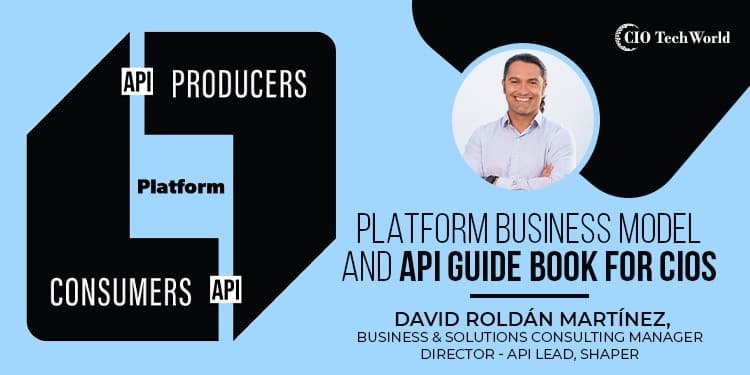Introduction
In the ever-evolving landscape of digital transformation, where innovation is the currency and disruption is the norm, C-level executives find themselves at the helm of strategic decision-making. As stewards of business growth and architects of organizational resilience, the imperative to grasp transformative models is paramount.
This article serves as a compass through the intricate realm of the platform business model, tailored for the discerning audience of CIOs and C-level executives from a business perspective. We embark on a strategic exploration, demystifying the complexities and nuances that define the platform paradigm, transcending traditional business approaches.
From redefining the dynamics of customer interactions to reshaping entire industries, the platform business model is not just a trend but a transformative force that demands the attention and strategic acumen of business leaders. Join us on this journey as we delve into the intricacies of platform dynamics, exploring how this model stands as a linchpin in the digital future, reshaping commerce, communication, and innovation.
As stewards of strategic vision, this exploration is not just about understanding; it’s about equipping business leaders with insights to navigate the future confidently. The platform business model is not merely a chapter in the evolution of business; it’s a new narrative, a strategic imperative that holds the key to unlocking unprecedented growth and resilience in the face of digital disruption.
Buckle up as we unravel the layers of the platform business model, uncovering its strategic implications, economic value-add, and the nuanced characteristics that distinguish it in the ever-evolving business ecosystem. This is not just a journey through concepts; it’s a strategic odyssey designed to empower business leaders in shaping a future where platforms are not just a part of the business – they define it.
What is the Platform Business Model?
A platform business model is a revolutionary approach to redefining the dynamics of business interactions. It acts as a mediator, orchestrating exchanges between consumers, producers, or service providers in a way that transcends traditional one-sided transactions.
In their most simple form, it is possible to distinguish between a supply and a demand side. Table 1 below shows some examples:
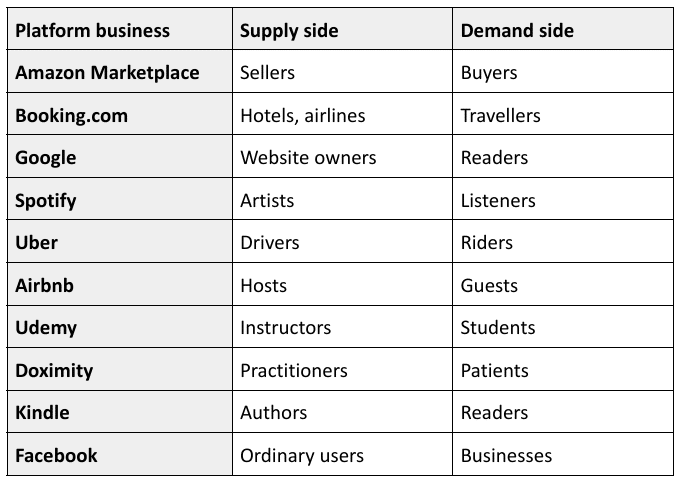
The main characteristic of a platform business model is the creation of an interconnected ecosystem where diverse parties can engage, collaborate, and transact seamlessly, rather than creating a linear value chain, typical of traditional business models.
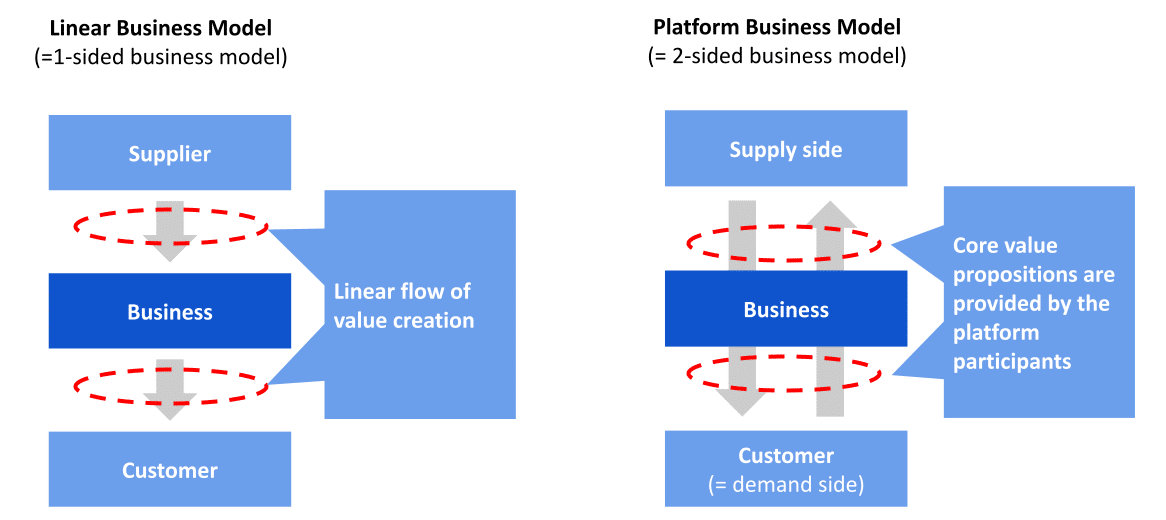
A platform ultimately enables this value creation by facilitating transactions. While a linear business creates value by manufacturing products or services, platforms create value by building connections and “manufacturing” transactions.
The core transaction is the platform’s “factory”— the way it manufactures value for its users. It is the process that turns potential connections into transactions. Getting the core transaction right is the most important part of platform design, as the platform business will need its users to repeat this process over and over to generate and exchange value.

However, although a platform enables the core transaction, it doesn’t directly control its users’ behaviors. The challenge is unique: how to get millions of people to behave the way you want them to. First, you must attract users to join, then you aid them by matching them together, providing the technology to facilitate the transaction, and establishing the rules that govern the network to build trust and maintain quality. These are the four core functions of a platform:
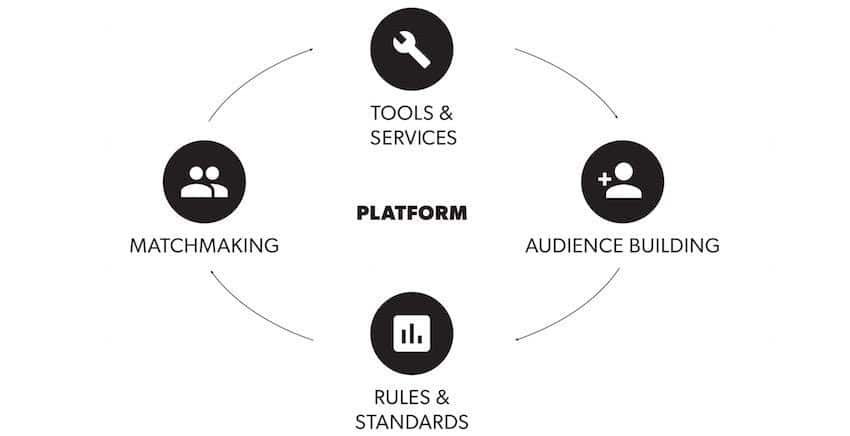
If a platform handles these four functions well enough, it will be able to facilitate its core transaction (and, hopefully, a lot of it).
Types & Examples
There are several platform business models, each with unique characteristics and ways of creating value:
- The Omni-channel Model: Omni-channel businesses provide customers access to their products across multiple channels, including physical and digital channels, giving them greater choice and a seamless experience.
- The Ecosystem Driver Model: Some companies, such as Amazon, Fidelity, Aetna, Apple, and Microsoft, establish an ecosystem by creating relationships with other providers that offer complementary (or sometimes competing) services. Ecosystem drivers provide a platform for the participants to conduct business; the platform can be more or less open. For example, Google has a very open platform, while Apple’s is more closed.
- The Modular Producer Model: Modular producers, such as PayPal, provide plug-and-play products or services that can adapt to a variety of ecosystems. To survive, modular producers must be among the best.
- The Supplier Model: Suppliers have, at best, partial knowledge of their end consumer, and typically operate in the value chain of another powerful company. Companies that sell insurance via independent agents (for example, Chubb Group), electronic goods through retailers (such as Sony), or mutual funds through brokers (for example, Vanguard) are suppliers.
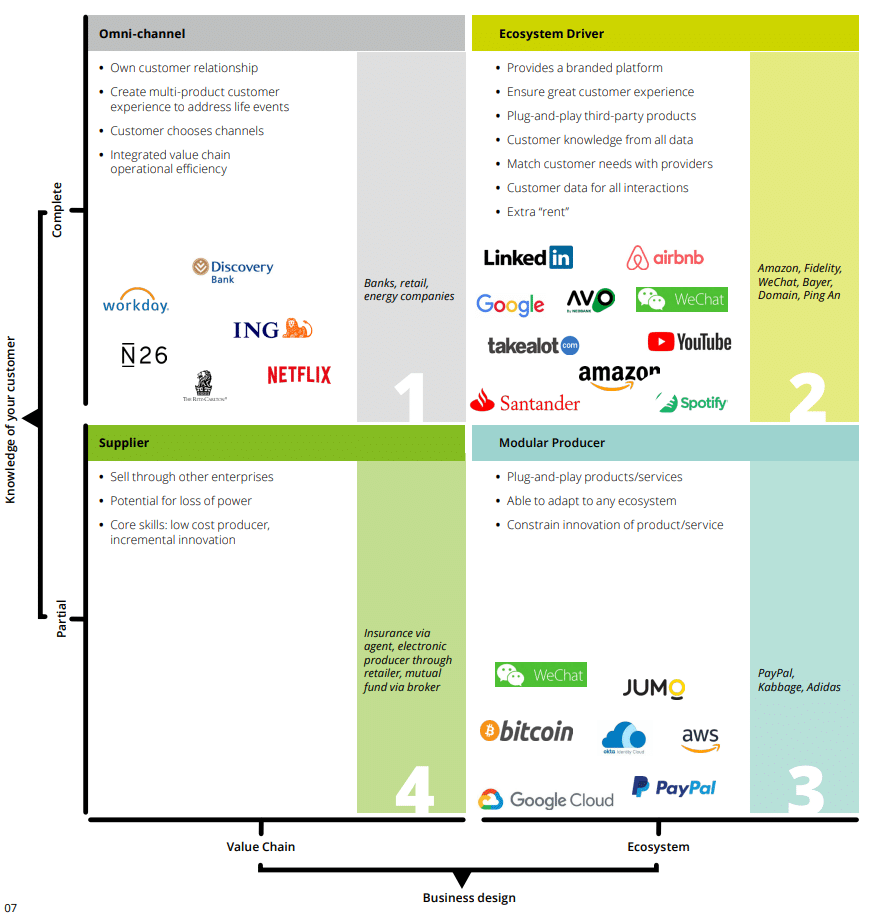
Key Characteristics
Platforms are fundamentally different from traditional linear business models. Linear business models are, for example, a production company – which buys raw materials, processes them, and sells the finished products. To better understand the difference, one should understand the following characteristics of platforms:
- Network effects: Network effects, a cornerstone of the platform model, go beyond a simple increase in users. It’s a self-reinforcing phenomenon where each new user enhances the value for all, creating a powerful competitive advantage and forming a barrier to entry for potential competitors.
- Externalizing internal costs: Platforms ingeniously externalize internal costs by reducing transaction and coordination expenses between user groups. This not only enhances the overall user experience but also allows platforms to claim a share of the value they facilitate.
- Search/Transaction costs: Reducing search and transaction costs is a pivotal characteristic. Platforms act as efficient matchmakers, streamlining the process of users finding each other, negotiating, and completing transactions, thereby removing friction from the interaction.
- Strategic positioning: Strategic positioning is a delicate dance for platforms. Balancing the interests of different stakeholders requires nuanced governance and regulatory strategies. Missteps can lead to challenges, from debates about freedom of expression to user safety concerns.
- Critical mass: Critical mass is the tipping point where a platform achieves sufficient size to trigger network effects and sustainable growth. Attaining this critical mass demands strategic long-term thinking, investment, and an acute understanding of user behavior.
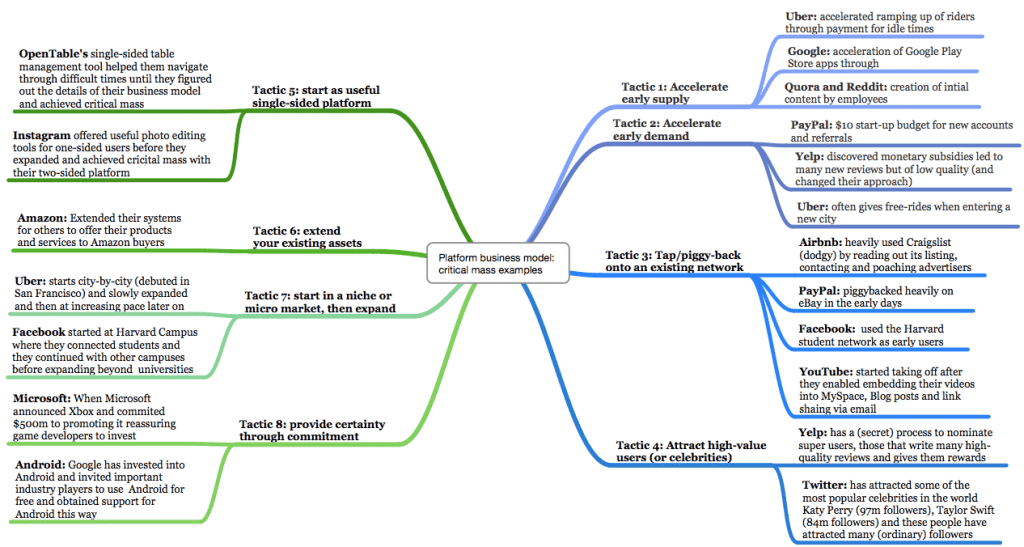
Building a Platform Business Model
Platforms need time, strategic long-term thinking, and some resources to develop it before you could even turn to monetization. The focus at the beginning should be on attracting and growing the critical sides of the user base (the hard-to-reach sides) of the platform. Without critical mass on both sides, monetization can undermine the foundation for long-term growth. Once both sides are sufficiently large, monetization is possible without compromising further growth.
When choosing the timing and strategy for monetization, the competitive dynamics must also be carefully considered. There are trade-offs between size, speed, and market share that need to be weighed here.

The Role of APIs in Platform Business
In the intricate architecture of platform business models, APIs emerge as the unsung heroes, silently orchestrating the symphony of interactions between diverse stakeholders. For C-level executives steering the ship of digital transformation, understanding the pivotal role of APIs is akin to holding the master key that unlocks the true potential of a platform.
At its core, a platform thrives on seamless interactions between users, be it buyers and sellers, service providers and consumers, or any other combination of interconnected parties. APIs serve as the conduits through which these interactions flow. By providing standardized interfaces, APIs ensure that diverse systems, applications, and services can communicate effortlessly, transcending the boundaries of disparate technologies.
On the other side, APIs are the catalysts for innovation within a platform ecosystem. They empower developers to build upon existing functionalities, creating a vibrant application marketplace that enhances the overall user experience. This not only fuels innovation but also propels the scalability of the platform. As new features and services can be seamlessly integrated through APIs, the platform can evolve rapidly without the need for extensive overhauls.
In addition, for CIOs and C-level executives, the strategic value of APIs lies in their ability to facilitate ecosystem expansion. Platforms often become hubs where third-party developers, partners, and other stakeholders contribute to the ecosystem’s richness. APIs act as the bridges that connect these contributors, allowing them to integrate their services and solutions, thereby augmenting the overall value proposition of the platform.
Finally, in the context of revenue models, APIs play a pivotal role. Many successful platforms leverage APIs not just as technical enablers but as strategic assets for monetization. By offering API access to third-party developers, platforms can diversify revenue streams through licensing fees, developer access fees, and revenue-sharing models, creating a symbiotic relationship where the platform’s success aligns with the success of its ecosystem.
For C-level executives keen on ensuring a superlative user experience, APIs are the linchpin. They enable the integration of complementary services seamlessly, enriching the overall offering. Whether it’s integrating payment gateways, third-party analytics, or any other service, APIs empower platforms to create a holistic and cohesive user experience.
Conclusions
As we navigate the strategic landscape of the platform business model, it becomes evident that this paradigm is not merely a trend but a transformative force shaping the future of commerce, communication, and innovation. For C-level executives, this journey holds profound implications, urging a reevaluation of traditional business approaches and the adoption of a dynamic, ecosystem-centric mindset.
Read more articles by David Roldán Martínez:
David Roldán Martínez: API Economy—The Trailblazer’s Guide for C-Level Leaders
David Roldán Martínez: Strategic API Governance Planning to Beat Challenges and Achieve Success

Expert in APIs, AI, Digital Transformation, Business Solutions, and Open Economy related sectors. I bring a unique blend of technical and business expertise to the table. With a proven track record of delivering successful solutions for businesses of all sizes, I have helped organizations develop innovative business solutions by understanding their pain points and challenges and designing a roadmap to overcome them and drive growth.
My extensive experience in APIs at all levels has enabled me to work on a variety of complex projects, from building custom integrations to managing complex API ecosystems. I have a deep understanding of the intricacies of the API landscape.



